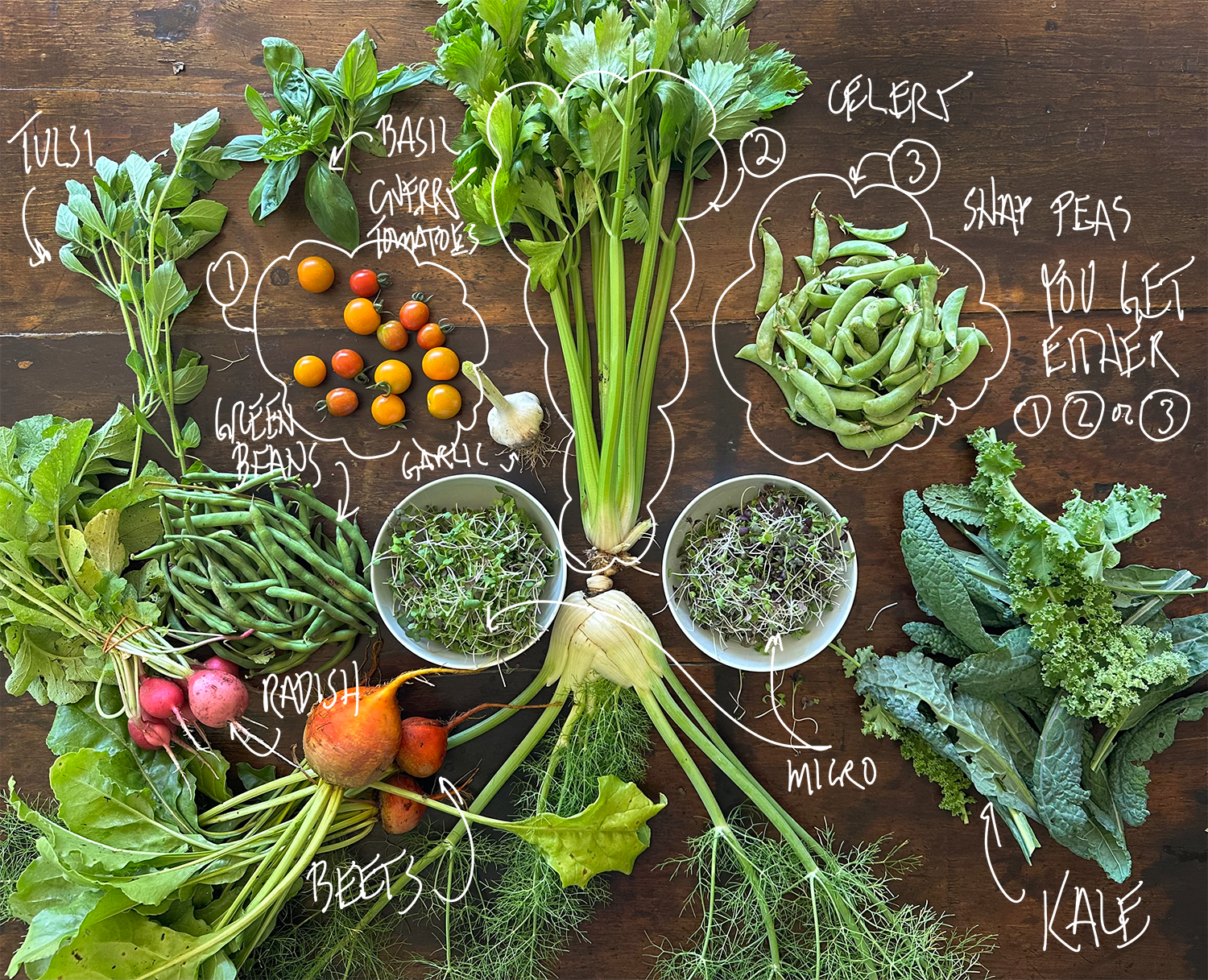2025 Season | Week 10
Garlic Harvest Days
It’s been a bit of a funny week—heavy rain Wednesday night, followed by our annual garlic harvest on Thursday. A big thank you to fellow YSFG shareholder Shelly Baxter for lending a hand! It was hot, humid, and a lot of work, but we harvested 500 feet of three garlic varieties. The bulbs are now drying on racks in the barn, with fans running to help cure them over the next few weeks.
That said, you can start enjoying fresh garlic right now. Curing just helps it store longer. From here on out, you’ll find garlic in every share—so get in the habit of cooking with the fresh stuff. Once you do, store-bought will never taste the same.
It’s been our best week for Microgreens this season. We have two varieties for you. Sprinkle them on everything!
We're in between a few crops this week, so your crate will include snap peas, cherry tomatoes, or celery. The snap peas are a bit past their prime but still fantastic roasted. The celery is small but packs flavor—perfect for elevating your chicken or tuna salad.
Wishing you a Happy 4th from all of us at Yankee Street Farm & Garden!
-
BEETS 101—Beets are healthy, versatile, taste amazing, and look beautiful. One of the best things about them is that they keep well before and after cooking, and every part is edible and delicious. Beets can be broiled, steamed, grilled, or roasted, our favorite. (We like cut beets roasted in olive oil and salt and pepper the best!)
EAT NOW—Roots: Just before cooking, scrub the beets well and remove any scraggly leaves and rootlets. If your recipe calls for raw beets, peel them with a knife or a veggie peeler, then grate or cut them according to the recipe. To remove the skins, roast them in foil or boil them, and the peels will slip right off.
Beet greens: Wash the leaves in a basin of lukewarm water to remove grit. Remove the thicker stems. Depending on use, cut the greens into appropriately sized pieces.
OR LATER - To Freeze: Beet Roots: Boil or bake beets until done. Cool them in ice water or let them come to room temperature. Remove peels. Trim the beets into 1/4-inch slices or keep them whole (if they are small). Place in a freezer bag and remove as much air as possible. Seal and freeze. Beet greens: Blanch wash beet greens for 2-3 minutes in hot boiling water. Immediately dunk in ice water to stop the cooking process. Then drain and pack into airtight containers. Freeze them in “balls” on a cookie sheet, then pop them into a freezer bag for the perfect portion.
DON’T TOSS THOSE BEET GREENS! - Beet greens are delicious! Here are some simple ways to use them: Use them for making vegetable stock, toss them into a salad — especially the smaller leaves, braised with a bit of olive oil, garlic, and pepper flakes, toss in a smoothie, add them to an omelet, frittata, or quiche, stir them into a pasta sauce in the final stages, add to a soup, like you would kale or spinach, turn them into a pesto
RECIPES
-
FENNEL 101
Fennel is a crisp, aromatic vegetable with a mild licorice flavor and a satisfying crunch. It's part of the carrot family but looks more like celery with its bulbous base, layered stalks, and feathery fronds. Both the bulb and the fronds are edible and versatile—great raw or cooked.EAT NOW
Slice the bulb thin and toss it into salads for a fresh, anise-sweet crunch. Shave it over pizza or tuck it into sandwiches for extra brightness. The fronds make a beautiful garnish and can be blended into dressings or sprinkled like herbs.OR LATER
Fennel mellows and sweetens as it cooks. Roast wedges alongside chicken or fish, sauté with onions for a simple side, or braise with broth and wine for a soft, savory treat. It stores well in the fridge, unwashed and wrapped in a damp towel, for up to a week—so you can enjoy it fresh today and tender tomorrow. -
Fresh Garlic 101
Fresh-harvested garlic, also known as “wet” or “green” garlic, is garlic that’s been pulled from the ground before it’s fully cured. Unlike the dry, papery bulbs you find in the store, fresh garlic has moist skins, juicy cloves, and sometimes green stalks still attached. The flavor is milder and more delicate than cured garlic, with a slightly grassy, almost sweet note—perfect for early summer cooking.Eat Now
Use fresh garlic anywhere you’d use regular garlic, but celebrate its tenderness! Slice or mince the cloves for sautés, salad dressings, or marinades. The juicy cloves melt beautifully into sauces, and the mild flavor makes it a lovely addition raw in dips or spreads. If the stalks are still soft, you can treat them like scallions—chop and toss into stir-fries, soups, or omelets.Eat Later
If you’re not using it right away, store fresh garlic in a cool, dry spot with good airflow. It won’t last as long as cured garlic—typically a few weeks—so keep an eye on it. To preserve the harvest, you can cure the garlic yourself by allowing it to dry for a few weeks, or peel and freeze the cloves for longer storage. Roasting and storing in oil (with proper safety precautions) is another delicious way to enjoy fresh garlic down the road. -
GREEN BEANS 101 - Turning a vibrant, beautiful green when cooked, string beans are versatile and delicious. Easy to prepare, string beans are great sautéed, roasted, grilled, or in stir-fry – we even like snacking on them while we cook! We believe simple is almost always better and like them best with a little of our 1808 Olive Oil, salt, and pepper. If you’re feeling spicy, try adding red pepper flakes.
EAT NOW - Rinse beans in cool water and pat dry. Snap off stem and any damaged parts before use. Can be eaten raw or cooked in a variety of delicious ways!
OR LATER - Store unwashed beans in a perforated plastic bag in the veggie bin of your fridge for up to 1 week. Rejuvenate limp beans by soaking them in ice water for 30 min. To freeze, blanch, dry well, and pack into airtight containers.
To blanch, bring a pot of lightly salted water to a rolling boil. While you wait for boil, prepare an ice bath. Once boiling, drop veggies into water - water should return to boil within a minute otherwise you have too much veg for the water. Once boil has returned, cook for 1-5 min until veg has a vibrant color. Immediately put into ice bath to stop cooking.
RECIPIES
-
KALE 101 - Wash leaves in lukewarm water. If your greens have thick stems, remove them by folding each leaf in half and slicing out the stem. Then, stack the leaves up and slice diagonally into 1” wide strips.
EAT NOW - Wrap unwashed chard or kale in a sealed plastic bag in the crisper drawer of the fridge. Best used very fresh, but may last for a week. To freeze, blanch washed greens, rinse in cold ice water, drain, and pack into airtight containers.
OR LATER - Swiss chard or kale can both be eaten raw or cooked. A longer cooking time is best as it brings out the sweetness in the greens. Extremely high in vitamin K and vitamin A, these nutrient-dense greens can help combat cancer and reduce blood pressure! Chard and kale can be used interchangeably with: collards, turnip greens, beet greens, broccoli raab, mustard greens, dandelion, and spinach.
-
Microgreens 101
Microgreens are the young, tender seedlings of herbs and vegetables, harvested just after they’ve sprouted their first true leaves. Despite their small size, they pack a big punch—rich in flavor, vibrant in color, and dense in nutrients. Common varieties include arugula, radish, sunflower, pea shoots, basil, and fennel, among many others. Grown in soil or hydroponically, microgreens are typically ready to harvest in 7–21 days, making them one of the fastest crops around.Eat Now
Microgreens are best enjoyed fresh! Sprinkle them over salads, tuck them into sandwiches or wraps, blend them into smoothies, or use them as a finishing touch on soups and eggs. Their flavor ranges from mild and sweet to spicy and bold, depending on the variety. They're an easy way to elevate any dish—both visually and nutritionally.Eat Later
To make the most of your microgreens, store them dry in an airtight container lined with a paper towel in the refrigerator. Most varieties will stay fresh for up to a week. If you get a living tray, you can harvest them as needed, ensuring peak freshness. Add them at the last moment when cooking or plating to preserve their delicate texture and vibrant color. -
SNAP PEAS 101 - Another item that should be eaten as soon as possible, peas are rich in vitamins A and C, thiamine, riboflavin and potassium. When raw, they make a delicious and healthy snack on their own, or can be added to salads. They can also be added to stir-fry or soup in the last stages of cooking. Steamed peas (til just tender-crisp) are great tossed with butter, olive oil, vinaigrette, or pesto!
EAT NOW - Snap peas need stringing. To do this, snap off stem tip toward the flat side of pod and pull down-ward. Fresh snap peas are delicious both raw and cooked.
OR LATER - Refrigerate in perforated plastic bag in the crisper drawer for 4-5 days. To keep longer, pea pods can be frozen. Blanch your peas, then freeze on a baking sheet (prevents clumping). Place in a plastic bag in the freezer up to 8 mo.
RECIPE
-
TOMATOES 101 - Probably the most versatile fruit in the garden, tomatoes can be used in countless ways - salsa, gazpacho, sauces, slow roasted, puree and even a bloody Mary. Ours are grown for taste so eat them right out of the crate.
EAT NOW - Store unripe tomatoes upside down on a plate at room temperature until they fully ripen. Wash, pat dry, slice or dice, and enjoy the taste of a real tomato.
OR LATER - Refrigerate any fully ripe tomatoes - allow to come to room temp before serving. To freeze, first blanch and dunk in ice water to cool. Remove stems and core. Transfer to storage bags, seal and place in freezer.
To blanch, bring a pot of lightly salted water to a rolling boil. While you wait for boil, prepare an ice bath. Once boiling, drop veggies into water - water should return to boil within a minute otherwise you have too much veg for the water. Once boil has returned, cook for 1-5 min until veg has a vibrant color. Immediately put into ice bath to stop cooking.
RECIPES

